#pictorial effect
Text
i never used to get boggarts in harry potter because as a child my deepest fear was 'the inevitable death of the universe' and i was like "okay boggart, how are you going to visualise that? turn into an image of the universe being destroyed? that would just look pretty cool. seeing a cool rendition of it wouldn't activate the fear" but now i am an adult (YIKES) and i wish my fears were that simple. i wish i could live in a world where my biggest problem was the fate of the universe itself. but no, going through my fears, my biggest fear is probably a certain friend of mine being mad at me but then thinking that i feared that too much and wouldn't show me it, hence her retreating from me and hiding the fact that she was mad at me, stopping us from working through it. And can you imagine how embarrassed i would be for her to see the boggart turn into a reclusive version of herself who won't talk to me!?
#how do u riddikulus that??#tbh my other fears wouldn't be very effectively utilised by a boggart#'being near a cow' sorry but being near a boggart would probably be scarier in itself#'fire' i know it's not a real fire. the concept of a boggart is scarier#'the dark' not technically a fear; doesn't count#'dehydration' in what way could that be pictorially represented to be scary?#'another one of my friends (c) being mad at me' yeah okay not sure how well i'd deal with that one either 💀. i could though. dw.
1 note
·
View note
Text
Two Theories About Vibes
When I hear people talk about vibes, I’m like a sardine out of a can – completely out of my natural habitat. But I overcame my bafflement. I persevered. And so here are two theories about vibes:
Vibes make you want to play the game in the first place: In a recent interview, Cole Wehrle, the designer of boardgames like Root, talks about a joke that he has with artist Kyle McFerrin. Wehrle says it’s Kyle’s job to make people play the game once and Wehrle’s job to make them place twice. It’s a joke but it points at something central, right? The design might be good but no one will find out if they don’t play it. So there’s a whole bunch of a stuff that goes into solving that problem: illustrations, sure, but premise, titles, taglines, graphic design, form factor, etc. To give a non-illustration example, Brindlewood Bay‘s premise of “grandmothers solve lovecraftian mysteries” is a vibe, right? For some people, it’s enough to get them to play it once. If they like the game design, they’ll come back and play it again. When a game is “just vibes”, there’s no design backing up the promise and often, your first time is the last time.
Vibes get you in the right headspace for the game to work: Sometimes, to play a game, you need to approach it the right way. Whether that’s knowledge of genre or a broader mindset shift, sometimes the game doesn’t work without it. The first thing that comes to mind is games where you “play to lose” and specifically, the joy of characters dying in horror games. But beyond that, there’s loads of other subtleties: should we be playing fast or slow, should we be taking this more seriously or less, should we be ready to cry at some point or maybe flirt, or maybe flirt and then cry? Now, again, this emerges from all the same constituent elements of vibes. You can definitely do it through text and sometimes, purely through the design. When a game is praised for having great vibes in this sense, its probably communicated the ideal headspace quickly, effectively and entertainingly. For a non-pictorial example, I think the title Monster of the Week does a great job of explaining exactly how you should think about the game as a potential player.
(This was first posted on the Indie RPG Newsletter.)
370 notes
·
View notes
Text
A new project: Devil Venerable Also Wants To Know! Oh man, so I've been leveling up in straw marquetry as fast as I possibly could. And it was VERY much with this goal in sight. Maybe not this book specifically, but my intention has been very much to bring this back around to books! And this one had a LOVELY vibe to go with the story, there's something so magnificent about Wenren È et al, this was a great vibe match for the story. I started reading this in 2021, stalled for some reason, and I'm SO glad I came back now!
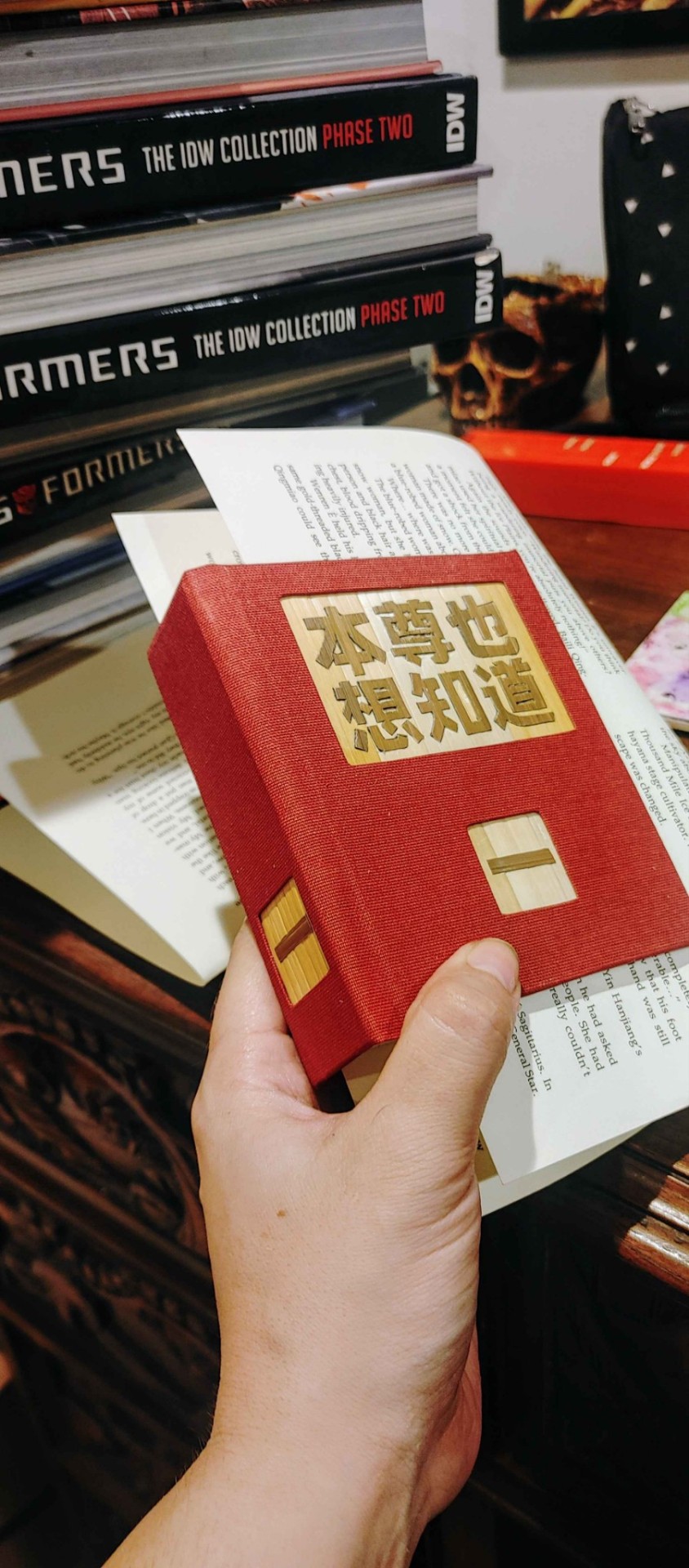
Especially as more and more of my faves get official licenses, those serve great as practical books, and I get more freedom to make my preservations of fan translations an extravagant expression of my love for the story and work that went into translating that. I got into this hobby assuming none of these novels would ever get official translations, so it's definitely something I've given a lot of consideration to over the last few years, and I think this set articulates it really well!


And oh man. I knew this was ambitious, but I still flew PRETTY darn close to the sun. I set this up so that each character had a nominal inch to work with, felt good about it, then opened up font previews for the text and immediately broke into a cold sweat. But with patience and lots of fresh knife blades, I got there! Cutting these pieces took some delicate wrangling, assembling them took more, and after all that, I still had to finish the cases and case in the books. But I made it work, and man, I think it really, really paid off

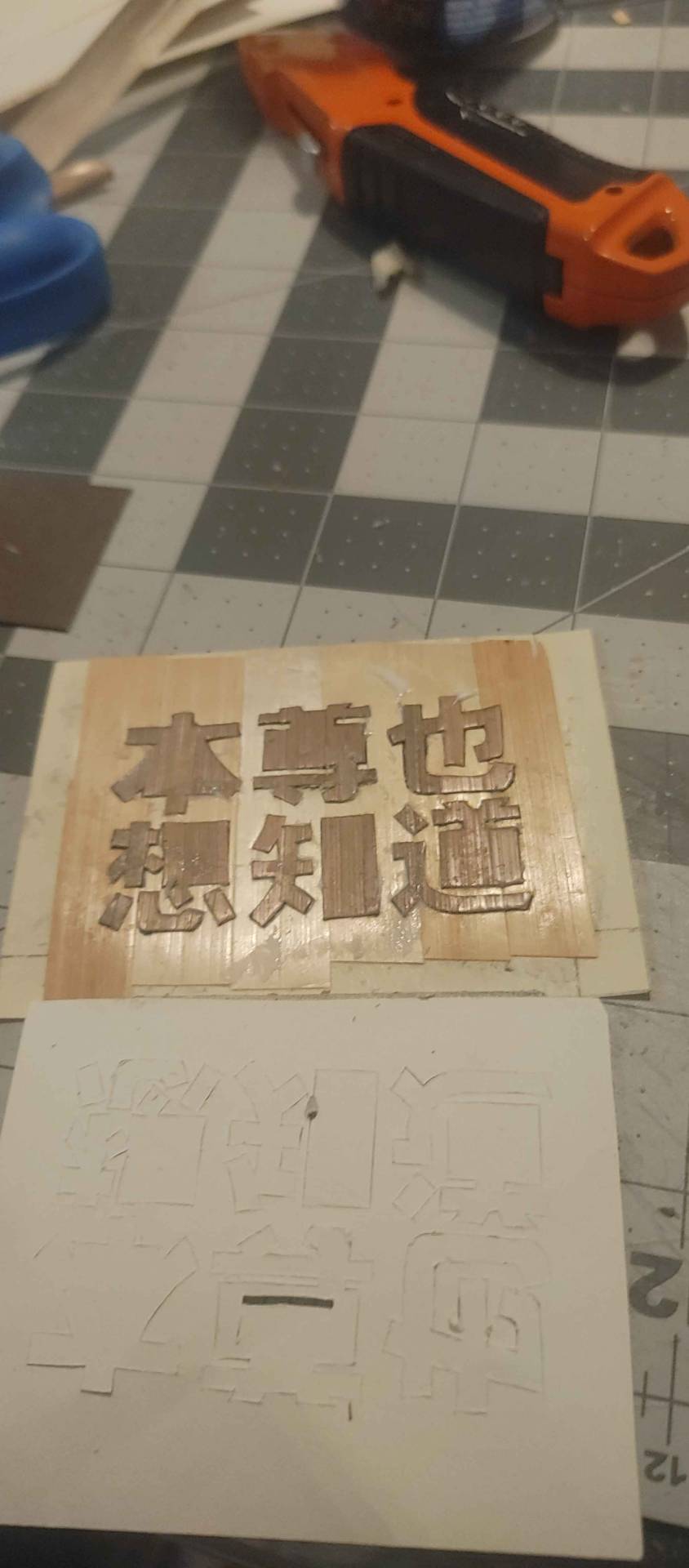

Did I tape my very first cutting template upside down? Don't worry about it!
And I was pleased with the straw marquetry on its own, but I have to say that attaching the boards for the cases took my delight ALL the way up to the next level. The effect is everything I could have dreamed of, which is amazing for a story that I loved so much. This is 1000% something I need to repeat, and it will probably take more practice before I reach the level I dream of, but SOMEDAY I'm gonna be doing pictorial straw marquetry on book covers. I might take a detour to more wall projects, and inlays with other materials, but soon! It's coming! And in the meantime, I'm so excited to share this with you, I think it turned out absolutely fabulous
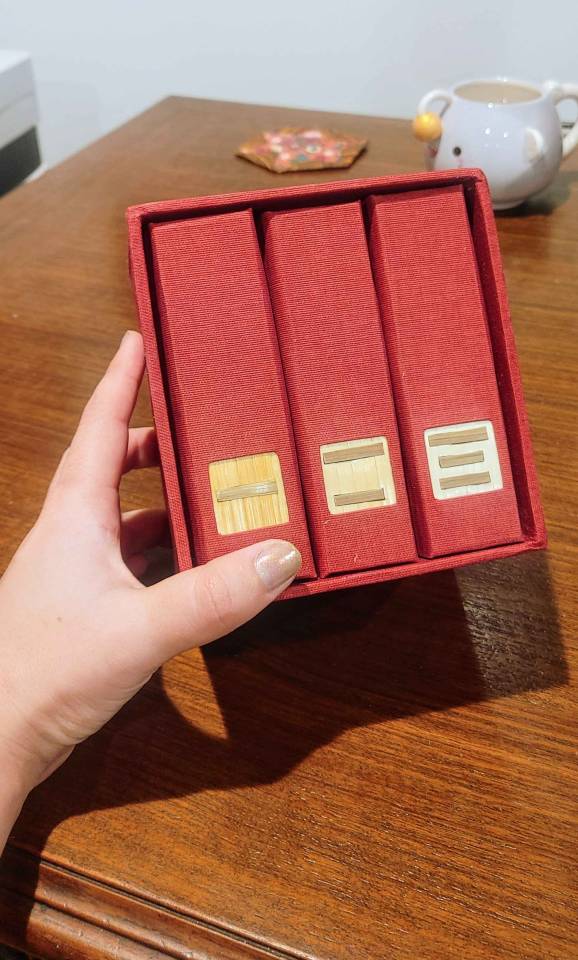


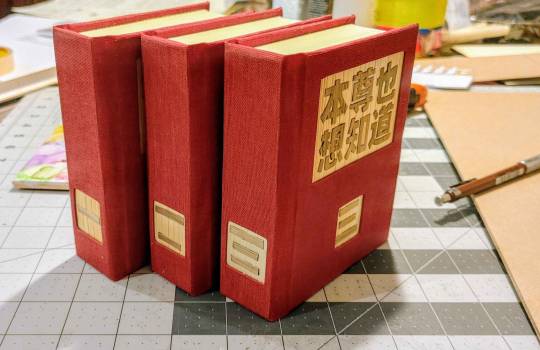
#devil venerable also wants to know#bookbinding#straw marquetry#box making#the textures are SO pleasing#if i do something like the jwqs set again#I'll have to see about doing a picture across the back of the box
116 notes
·
View notes
Text
OBSCURA trailer analysis & theories
The OBSCURA trailer is very pretty (watch it if you haven’t already <3) and is also full of interesting symbolism and snippets of Latin. In this post I’m going to be manually translating and providing notes on the Latin, as well as discussing what the numbers mean and giving my own plot speculations. SPOILERS for OBSCURA’s Chapter 1 with every love interest.
I’m going to be working with the theory that the numbers correspond to the Major Arcana in a Rider–Waite–Smith tarot deck. I’ll be pulling tarot card information from A.E. Waite’s 1910 book ‘The Pictorial Key to the Tarot’, where he discusses the symbolism of the images in the cards and provides divinatory meanings.
Shoutout to @/starlitmanta and @/mostlygayrage for posting their own analyses before me! I got inspired by both of them to both write down my thoughts and then actually finish the post after leaving it for months lol. @/mostlygayrage has some interesting stuff on the imagery and also delved into the Latin! Although he took it as one sentence which I won’t be doing – I’m going to take the double forward slashes as an indication of a break.
Disclaimer that I haven’t formally studied Latin in years so if there are any errors feel free to point it out in the notes!
Cirrus
18. Presbyter // Ecclesiae lunaris
XVII: The Moon. Priest // Lunar churches
18. Obsequium // ducit ad caelum
Obedience // he leads to heaven
TL notes
N/A
Tarot meaning
To quote Waite, “The moon is increasing on what is called the side of mercy… the path between the towers is the issue into the unknown. The dog and wolf are the fears of the natural mind in the presence of that place of exit, when there is only reflected light to guide it…the message is: Peace, be still; and it may be that there shall come a calm upon the animal nature...”
Upright: Hidden enemies, danger, darkness, terror, deception, occult forces, error.
Reversed: Instability, inconstancy, silence, lesser degrees of deception and error.
Speculation
I think we can all agree that Cirrus is not trustworthy, hence danger, deception, occult forces etc. Nevertheless, Vesper (if you’ve got a good ending, at least) puts great degrees of trust in him. ‘A calm upon the animal nature’ calls to mind his odd ability to influence Vesper’s choices and force them into saying ‘yes’, but I also thought it might reference something about Vesper putting aside their instinctive reservations about Cirrus’ suspicious character to follow him into an unknown future.
Leading to heaven is, to me, a bit double-edged; it could mean death or paradise. Very fitting, I think.
Keir
20. Keir // Cavillatur fur
XX: Judgement. Keir // Mocking thief
20. Fatum // vestrum vel extraneus
[Destiny / (calamitous) death] // yours or a stranger
TL notes
I’m inclined to believe that Keir’s name being his plain name rather than an epithet is probably just part of his blunt kind of character, and ‘mocking thief’ is probably related to his personality too. Also, there is another piece of Latin on that first screen – ‘cultellus’, which means ‘dagger’ and points downwards towards where his dagger is held. Also, ‘fatum’ is a very interesting word in that it carries an intriguing potential double meaning.
Tarot meaning
Upright: Change of position, renewal, outcome.
Reversed: Weakness, pusillanimity, simplicity; also deliberation, decision, sentence.
Speculation
Waite’s initial discussion of Judgement is very Biblical which I doubt has much to do with OBSCURA’s use of it. I do think the divinatory meanings are very interesting – I think that at a good/best end of Keir’s route, he’ll be able to come out on top and secure a good and/or stable future for himself and/or Mouse Hole.
My current theory is that, since we have had mentions of Keir and Oleander in each others’ routes, that they have direct effects on each others’ fates. This fits with ‘yours or a stranger’ of course, but also the double-edged ‘destiny or (calamitous) death’ – I’ll speculate more in Oleander’s route, but I think he and potentially most of Mouse Hole will not fare well if Vesper picks Oleander.
I’m interested in why his dagger was explicitly pointed out and labelled. I’m kind of shooting in the dark here but I think it’ll be significant in the future – either as a symbol of his history (specifically with Oleander, perhaps?) or as a plot device of some sort.
Oleander
11. Nerii // Periculosum scurra
XI: Justice. Of oleander // Dangerous clown
11. Patiuntur // sicut habes
They are suffering // just like you are
TL notes
More technically, ‘nerii’ is the genitive of ‘nerium’, which means oleander. This makes sense to me when I think about how he’s had a history of changing names – he’s moreso embodying the qualities of oleander (a pretty but dangerous plant) rather than taking it as a definitive name.
‘Patiuntur’ is in the plural, and suffering might be a strong word depending on how you look at it – the original word is like enduring through something difficult or unpleasant.
Tarot meaning
Waite basically says that the card has ‘obvious meanings’ so I don’t think I need to look too closely into it.
Upright: Equity, rightness, probity, executive; triumph of the deserving side in law.
Reversed: Law in all its departments, legal complications, bigotry, bias, excessive severity
Speculation
The second half of the second piece of Latin, ‘sicut habes’, is in the second-person and I’m assuming that this is meant to address Vesper/MC. Maybe Oleander is also looking for something that he can’t find or afford, although the plural throws me off a bit if that’s the case. Maybe it’s referencing Oleander’s previous Vigils (since Vesper is currently holding that position, ‘just like’ they have) or something…?
Now, here is my plot theory which may or may not be insane. We know that Oleander has committed murder, and was very blasé about it; presumably he’s done this sort of thing before. We know that in his route, Keir has been alluded to, Griff has shown up and Keir is presumably going to show up at some point. I think that Oleander’s involvement with Keir is going to end very poorly for Keir, even leading to the calamity insinuated in Judgement. Specifically, I think that Oleander and Keir are going to be caught up in a serious crime and Keir is going to take the fall, leading to a permanent end for him (death, probably) and the following collapse of Mouse Hole. Oleander will get off lightly or scot-free (Justice’s ‘triumph of the deserving side in law’, ‘deserving’ as opposed to Keir who is indisputably a criminal and receives ‘excessive severity’).
This could be from Keir and his group failing the burglary since Vesper isn’t there to cover for the injured lookout, or it could be something else that brings in the dagger which was pointed out in Keir's portion of the trailer. I’m thinking murder, honestly.
Francesco
10. Franciscum // innocentes nobiles
X: Wheel of Fortune. Francisco // innocent nobles
10. Tempus // decurrit
Time // runs out
TL notes
Grammatically, ‘Franciscum’ is in the accusative (the case used to mark the ‘object’ on which a verb acts). This could be a stylistic thing or it could allude to how he’s being ‘acted upon’ by whatever power/influence his family have.
‘Decurrit’ is literally ‘runs down’ which fits with the hourglass imagery, but I imagine that the spirit of the phrase is ‘runs out’ especially since his route already alludes to that.
Tarot meaning
To quote Waite, “the symbolic picture stands for the perpetual motion of a fluidic universe and for the flux of human life … the essential idea of stability amidst movement. Behind the general notion expressed in the symbol there lies the denial of chance and the fatality which is implied therein.”
Upright: destiny, fortune, elevation, luck, felicity.
Reversed: increase, abundance, superfluity.
Speculation
I think that at some point within Francesco’s route, his family is going to be further involved. I assume that these are the ‘innocent nobles’, which makes me think that whatever state or situation that they find Francesco in won’t be very innocent at all. Alternatively, it could be that his family is more innocent/harmless than they present themselves as – depending on circumstance, this could be a big win for Vesper or a big loss because they don’t have the family backing that they thought they did.
The Wheel of Fortune carries connotations of luck and change in fortune. I assume that Vesper provides Francesco with some degree of ‘stability amidst movement’ and that any ‘denial of chance’ involves Francesco leaving the marketplace and returning to the very clearly mapped out future that his family has for him, thus leading to a bad end.
——————————
Thanks for reading to the end!
89 notes
·
View notes
Text
Bestiaryposting Results: Hratgrog
This week's installment is once again coming kind of late in the evening -- and a bit less wordy than usual -- because I just got back from the ICMS conference at Kalamazoo last night and have been running around doing stuff all day. So, sorry about that.
Anyway, also worth noting that a surprising number of people have indicated that they know this one.
If you aren't sure what this is about, you can find an explanation and previous posts at https://maniculum.tumblr.com/bestiaryposting.
You can also find the entry people are working from here:
If you want to participate in the next installment, you can find the entries posted under the tag maniculum bestiaryposting. Also, to make it easier on y'all, here's the current one:
Anyway, art below the cut in the order it was posted:
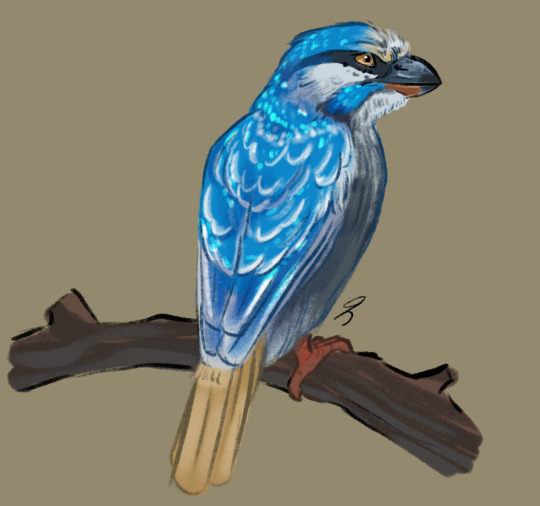
@silverhart-makes-art (link to post here) took the description of the animal's behavior and designed a bird who could feasibly fit that -- if you want the details on what birds went into this and why, they're in the linked post. I particularly like the iridescent effect on the feathers.
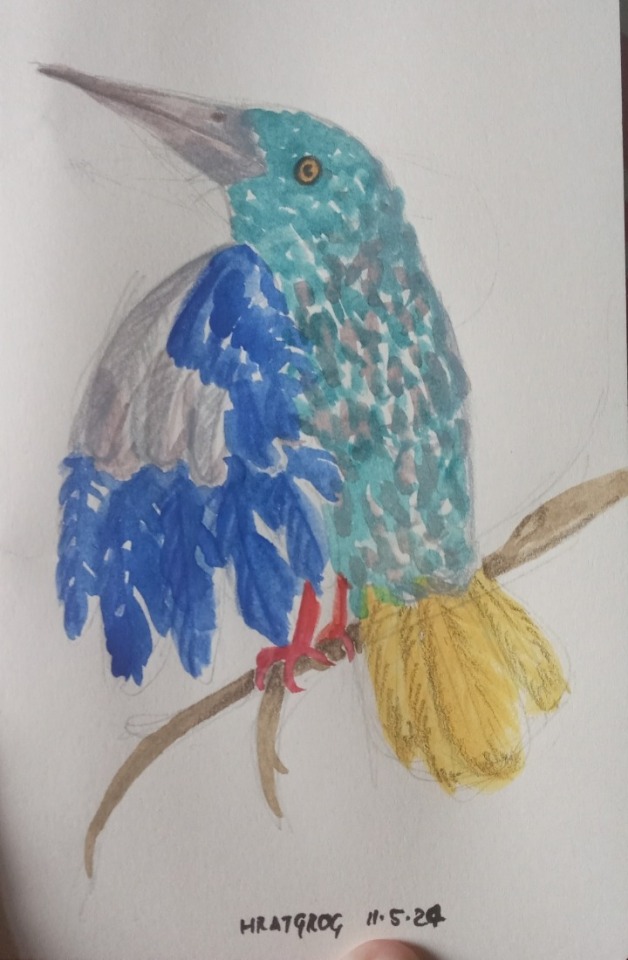
@sweetlyfez (link to post here) also drew a bird, but went in a different direction with the references, eschewing them entirely on the grounds that the monks probably didn't have any references on hand. I think the "colour of a wild sea" comes out well here.

@cheapsweets (link to post here) decided to resolve the issue of the wings being sapphire but also "sheathed in silver" by making the Hratgrog a beetle with silver elytra, which I think is quite clever. Again, the colors are very good in my opinion -- and as usual, you should check the linked post for an explanation of the design.

@coolest-capybara (link to post here) has, as per usual, done some amazing medieval stylization. I find this landscape really pleasant, birds aside. The design of the creature is also really solid, and you can find an interesting description of why it looks the way it does in the linked post. I would particularly draw attention to the interpretation of how this bird "does not live by theft", which you will have to click the link to find out.

@strixcattus (link to post here) gives us a bird that appears to be waving to us. Again, I like the coloration here; the many lines really add to the effect. Clicking the linked post will get you Strixcattus's modern interpretation of this animal, which includes a brief explanation of why it's necessary to specify that this bird does not eat corpses.
All right, to the Aberdeen Bestiary:


Or, rather, a dove.
(The distinction drawn between dove and pigeon in modern English is not formalized or universal, but the translation I'm using says "dove".)
The description for this page in the digitized manuscript notes:
This rather plain lifeless bird does not do justice to the luscious pictorial descriptions devoted to the dove on ff.26-30r. However, raking light reveals a lustrous silvered quality to the paint.
Since the description goes on so long -- like I said, I was excerpting bits of physical description from a lengthy sermon on symbolism -- there are actually multiple illustrations. It looks like there were originally four, but two have been cut out of the manuscript. The other surviving one is as follows:
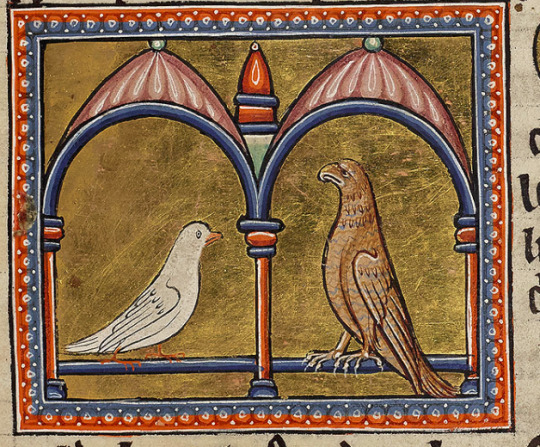
That would be the Hratgrog on the left -- the bird on the right is its antagonist, the hawk. No word on why this one doesn't get any coloration.
Anyway... how do I end this one?
Go forth and contemplate the pigeon. It's what the bestiary author would want.
35 notes
·
View notes
Text
The Dragon Boat Festival or Duan Wu Jie (端午节), is also known as Duan Yang Jie (端阳节), which means “Upright Sun” or “Double Fifth” (重午/重五). Falling on the fifth day of the fifth lunar month around the summer solstice which happened to be 10th June 2024 this year. The festival is also commonly referred to as the Fifth Month Festival amongst the Chinese. Its origins can be traced to southern China, and festivities include boat races and eating rice dumplings. The festival had evolved from the practice of revering the river dragon, to the commemoration of Qu Yuan (屈原), a third-century poet and political figure of the state of Chu in ancient China.

Legends and Myths - River Dragon (蛟龙)
The dragon was initially viewed as the benevolent spirit of the waters. It exemplified the masculine principle or yang in the Chinese ideology of harmony. Among common folk, it was believed that the River Dragon (蛟龙) controlled the rain and was thus worshipped during the summer solstice. Requests would be made for a balanced rainfall – sufficient to ensure a good harvest, without over-abundance that would cause destructive flooding.

Legends and Myths - Qu Yuan (屈原)
Primitive worship of the river dragon was often practised during the summer solstice. The Dragon Boat Festival was associated with Qu Yuan’s story only in the second century. Qu Yuan (屈原) was a poet and a statesman for the Chu kingdom (楚国) during the Warring States Period (战国时代). He served in high office and he advocated a policy of aligning with other kingdoms against the dominant Qin. However, political intrigue led Lord Huai to banish Qu Yuan instead. The ministry was left in the hands of corrupt statesmen and Qu Yuan helplessly watched his motherland decline. Depressed, he penned beautiful, patriotic poetry such as Li Sao (离骚) which means Encountering Sorrow, an allegorical poem stating his political aspirations and Jiu Ge (九歌) or Nine Songs, which gained Qu Yuan great renown.
youtube
With his top adviser gone, the king fell for the trickery of the Qin and his kingdom was eventually conquered. Upon hearing that his kingdom’s capital had been overtaken by the Qin, Qu Yuan committed suicide by drowning himself in the Mi Luo River (汨罗江). As he was adored by people everywhere, the local people did everything in their power to try to either save Qu Yuan, or at the very least, to protect him in the afterlife.

Hereupon the legend varies. Some suggest that fishermen at the scene attempted to save their minister. Having failed, they sought to appease his spirit by throwing rice stuffed in bamboo stems into the river to prevent the fish from eating Qu Yuan’s body. Others say that the rice offerings were snatched by a river dragon and the rice had to be bundled in chinaberry leaves instead and tied with five different coloured silk threads in order to be effective. The triangular Rice Dumplings (粽子) thus became entwined with the festivities. Another version tells of farmers rowing out in dragon boats in their attempt to save Qu Yuan. Hence, Dragon Boat Racing (赛龙舟) has been held annually on the fifth day of the fifth lunar month, in honour of the memory of Qu Yuan.

Or if reading through a wall of texts is not your cup of tea, here is a pictorial guide to summarize on the history of Qu Yuan (屈原) and how we ended up celebrating Dragon Boat Festival (端午节) with dragon boat racing and rice dumplings on the fifth day of the fifth lunar month.

All images are from the internet. Selected text info from here.
#Dragon Boat Festival#端午节#农历五月初五#Qu Yuan#屈原#Rice Dumpling#粽子#Bamboo Leaf#Dragon Boat Racing#赛龙舟#Festival#Tradition#Chinese Culture#Video#Youtube#Food#Buffetlicious
46 notes
·
View notes
Text
Regarding this post going around:

Recommend checking out an article by Kasey Keeler and Ryan Hellenbrand, published at Edge Effects in 2021, which, aside from addressing the Ojibwe story about the Nanabozho fighting against logging, also describes the origin of Paul Bunyan as an icon of clear-cutting timber industry and, later, as a symbol of the advent of the US federal government’s “German-style” forestry management.
Some quick tidbits from their article:
- References to Bunyan appear in local print media from the 1890s onward, but Bunyan became more widely known in 1916 after a scholarly publication about the folklore. In the same year, 1916, an important mass media pictorial representation was made in a promotional pamphlet by the marketing team of a major logging company as a move to give them a folksly and “local” charm as the corporation expanded from Minnesota to California.
- That same logging company had owned the land that would become both Paul Bunyan State Forest and Chippewa National Forest.
- The first national forest created by act of Congress rather than presidential proclamation was actually Chippewa National Forest, which has been described as “a laboratory” to solve “the Indian problem” and discipline/contain Ojibwe people.
- Paul Bunyan was a sort of icon of German folklore in the region. Ironically, even though Bunyan was originally associated with clear-cutting, it would in fact be "German-style” forestry policy that (in Minnesota and later across the US) replaced the original clear-cutting industrial extraction methods with a "modern" and "sustainable" management approach meant for "sustained yield" (which still just treats forests as a resource to be extracted for profit).
---
Anyway, some images, captions, and text from the article [all text below is excerpted from the article]:
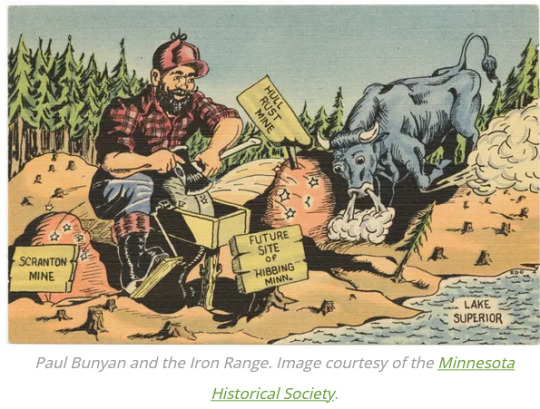
Across the Northwoods, a geography that spans the U.S.-Canada border, stories are used to make and claim space. [...] Throughout northern Minnesota, legends of Paul Bunyan, the fictional giant lumberjack, have been used to claim space. [...] Bunyan has been credited with creating Minnesota’s 10,000 lakes, the Mississippi River, and the Grand Canyon, while simultaneously logging millions of acres of forest. [...] Together, we juxtapose the history of two forests -- the Paul Bunyan State Forest and the Chippewa National Forest -- to reveal how German settlement, logging, and forestry have contributed to placemaking narratives, and how [...] nostalgia links past and present. Paul Bunyan’s literal and figurative imaginings advance American Indian erasure narratives, leading to the invisibility of these same communities today. [...] The Northwoods have been popularized and imagined as America’s version of northern Europe. [...] Across Minnesota, towns like New Ulm, New Munich, Heidelberg, and Luxemburg bear witness [...]. More recently, Native scholars Michael Dockry and Christopher Caldwell have examined [...] “the Menominee people’s profound sense of place and their intimate relationship with place.” [...]
---
Ojibwe dispossession, well underway by the late nineteenth century, is not told in any Paul Bunyan story. [...] The "heroic labor" of logging formed a significant portion of Great Lakes region economies [...] on the heels of, and entangled with, Ojibwe dispossession. [...] Formally established in 1908, the 1.6-million-acre Chippewa National Forest (CNF) lies nearly contiguous with the Leech Lake Reservation. [...] [T]he CNF was the first national forest created "for the benefit of [American] Indian people." [...] In 1902 came the Morris Act. Authored by [a] Duluth congressman [...], the act "created the first forest reserve established by congressional action rather than presidential proclamation." The act established the 225,000-acre Minnesota Forest Reserve as a “compromise,” a way to tackle the “Indian problem” while allowing for timber harvest. Here, Ojibwe homelands became “a laboratory for the first comprehensive forest management plans undertaken by a federal agency.” In 1928, the forest was renamed the Chippewa National Forest, as it remains today.
---
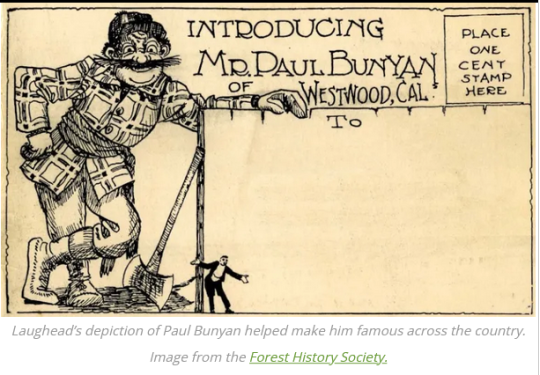
While the Chippewa National Forest forces us to consider the many ways logging and forestry has usurped American Indian peoples’ access to land, the nearby Paul Bunyan State Forest encapsulates the material legacy of symbolic myth. [...]
Officially recognized in 1935, the Paul Bunyan State Forest evolved from the site of the Red River Lumber Company sawmill. Founded in 1884, the Red River Lumber Company (RRLC) directly participated in and contributed to Ojibwe dispossession. By the end of the nineteenth century, he RRLC had purchased most of the land that comprises the present-day Pual Bunyan State Forest, milling millions of board feet of lumber at the company town of Akeley. [...]
The expansion of RRLC to California precipitated another key move: using Paul Bunyan in their marketing. William B. Laughead (pronounced Log-head), advertising manager in 1914 and a logger himself, spun another Paul Bunyan tale for the promotional booklet “Introducing Mr. Paul Bunyan of Westwood, Cal,” which included Bunyan’s first pictorial representation. This marketing campaign relied on the new and growing nostalgia for the grand logging days in the Great Lakes to keep the transcontinental corporation rooted in place.

With logging long established throughout the Great Lakes region, the ecological damage was clear. To remedy this, in the mid-1930s (German) forestry was introduced to manage timber on a sustained yield base. This, then, is the irony of the Paul Bunyan State Forest: named for an American legends who is said to have literally cleared the path for settlement, forest management now proposes to maintain the integrity of the forest. [...]
Though Paul Bunyan narratives dominate the landscape of the Northwoods, if we look closely we can see the ways Native people resist the legendary exploits. Indeed, a lesser-known Ojibwe oral story reminds us that the Anishinaabe people, their culture, and their histories will always prevail over dispossession and logging. In the story, Nanabozho, an Ojibwe trickster or cultural figure, confronts Paul Bunyan, who had already logged off most of the northeastern states before making his way to Minnesota. Nanabozho tells Paul to leave, to not log any more timber. A fight ensues, and [...] Nanabozho swings a Red Lake walleye at Paul, knocking him off his feet. As Paul stumbles, Nanabozho pulls at Paul’s whiskers, making him promise to leave the area. This is why, today, Paul Bunyan does not have a beard and why he is facing west at the statue on Lake Bemidji, as he prepares to leave the region.
This is also why we have the Chippewa National Forest, because Nanabozho and his Ojibwe kinsmen saved it from being logged. It is this contemporary narrative that highlights the complexity of Ojibwe storytelling [...].
---
Images, captions, and text as published by: Kasey Keeler and Ryan Hellenbrand. “Paul Bunyan and Settler Nostalgia in the Northwoods.” Edge Effects. 2 December 2021. [Bold emphasis and some paragraph breaks added by me.]
#abolition#ecology#indigenous#great lakes#imperial#colonial#ojibwe#victorian and edwardian popular culture#tidalectics#imperial forestry#multispecies#interspecies#geographic imaginaries
383 notes
·
View notes
Text

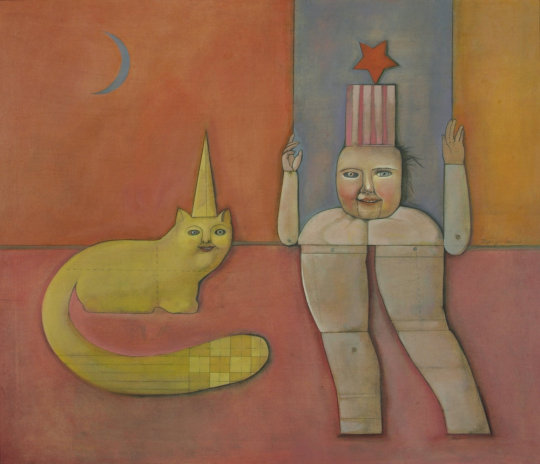

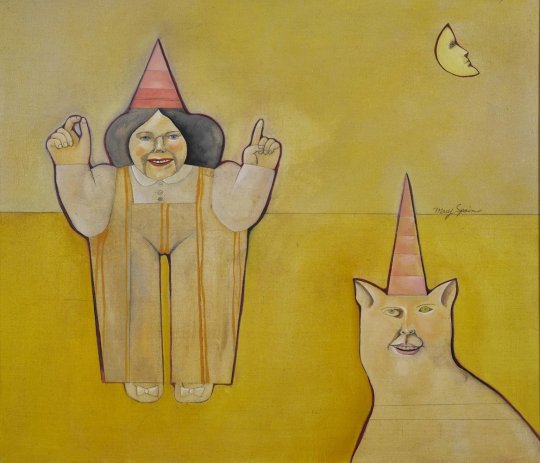



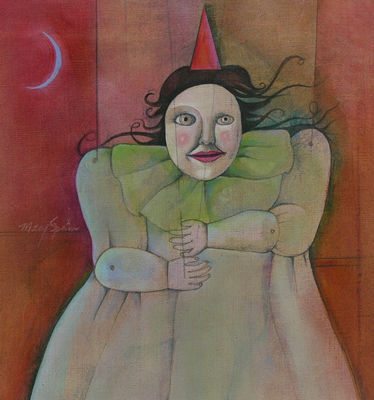
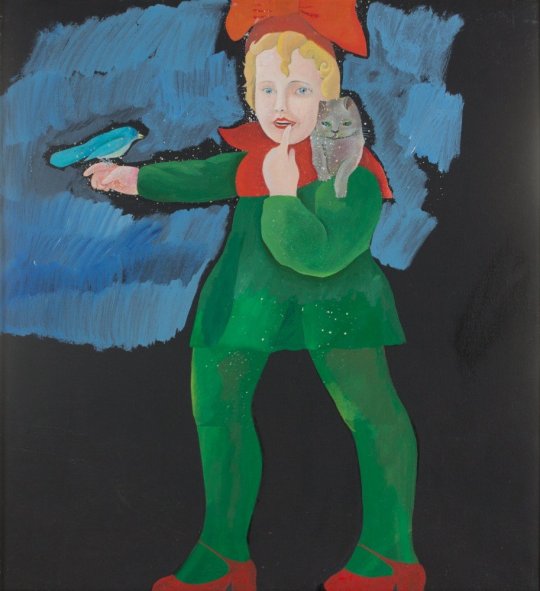
MARY SPAIN
American, 1934–1983
"As a small girl, Lisa Eastman lived across the lane from a magical woman who moved effortlessly across sun-dappled wood floors, under cathedral ceilings and surrounded by large colorful paintings. The smell of oil paints filled the air, casting a powerful spell on the younger girl. “That’s when I knew I wanted to be a painter.” Mary Spain Colie had spread her magical life to another generation, though her own life ended before middle age.
The details of Mary Spain’s life are sketchy, drawn more in paint and sculpture than biographical details. She grew up in North Carolina, but shared a creative soul with famed Belgian artist, Rene Magritte whose work pulled her away from the Expressionist landscapes that defined her early career. Later she moved to Ohio to teach art at Chagrin Falls High School and lived a quiet life with her husband Frederic Colie, a fireman, outdoorsman, and commercial chemicals salesman.
The parallels between their lives and works are hard to ignore. Putting Magritte’s renowned “Son of Man,” beside any of Mary Spain’s many masked figures makes one question the effects of having a world war take place in your back yard or childhood. Magritte’s response was to probe deeper and deeper into Surrealism, a style that challenged viewers perceptions of reality. He became one of only a handful of surrealistic masters.
Mary Spain, on the other hand, escaped to her magical kingdom on the banks of the Chagrin River. There she captured a world others couldn’t see in surrealistic images of people and animals, often mechanical, always mysteriously hidden behind masked faces. Certainly they were influenced by her collection of antique dolls, but where did her love of dolls and whimsical images come from? One art critic wrote: “Exactly when Mary Spain tumbled into her pictorial Looking-Glass world is difficult to determine. She may have been born there.” Only Mary Spain Colie knew for sure, and her voice was silenced by cancer at the young age of 49. Magritte lived two decades longer, but succumbed too early to the same horrible disease.
Her husband, Frederic, had supported his wife’s career by forging relationships with galleries in Cleveland, New York and Florida. After her death he withdrew all her paintings and sculptures from those galleries. They were never again offered for sale until after his own death in 2012."
https://wolfsgallery.com/.../mary-spain-girl-tossing...
46 notes
·
View notes
Text
R1999: Just Reports (1.9 Lead-up In-game Activity)
in-game activity where a report is unlocked each day for five days; each day you are made to enter a password. you are given a code, enter the corresponding letters and that's the password. you get 400 clear drops, 5 picrasma candy, and other goodies. happy first anniversary, r1999

Day.1 (pw: boring)
/Survival Report
Congratulations on successfully completing the test. Those that independently cracked the code are deemed to have a highly developed left brain and are considered to be able to read the report on their own.
The following is the information contained in the report: None. In accordance with Laplace guidelines and the assigned task of deciphering the incantation, regular progress updates will be provided over the next twenty-two hours to document and verify advancements.
Summary: Currently, vital signs remain confirmed

Day.2 (pw: mrfishjar)
/Observation of the Teamlead
Based on internal data at Laplace, writing reports is considered as the second most effective way to prolong the perception of time; reading reports is the first.
In this report, I have noted that the teamlead showed signs of anxiety and became unusually irritable during our decoding operation. As part of my duties and out of personal interest, I will continue to monitor any fluctuations in the teamlead's emotional well-being.
Conclusion: It is generally accepted that straight lines represent relaxed eyebrows, while curved lines indicate a smiling mouth. The complete deciphering of facial expressions is fast approaching.

Day.3 (pw: msuncanny)
/Observation of the Director
I understand that the reader may not have enough free time to continue reading this report unless it is necessary for their job; my apologies.
The following is the content of the report: The director appeared emotionally stable when presented with the interim results of the decryption operation. Correction: I cannot confirm any noticeable emotional fluctuations in the director; they seem to be stable for the time being. Further observation will be temporarily suspended.
Summary: The expression system is the same as the masks, and after a right-brain assessment, I can no longer trust the verifiability of the emotions conveyed by this system.

Day.4 (pw: ihatearts)
/Day of Art Appreciation
Aside from upholding confidentiality obligations, the main purpose of the code is to weed out people with highly developed right brains, such as certain artists and arcanists.
The following is the content of this report: Efforts to decipher the pictorial messages sent by the investigators were unsuccessful. A proposal to go outside and turn into oil paintings to better connect with the artwork was rejected.
Summary: I strongly believe that combining cryptography with the works of Leonardo da Vinci has the potential to create a unique form of literature that would captivate and engage a wider audience.

Day.5 (pw: goodbye)
/Application for Leave
This report assumes that the reader has most likely skipped the first four reports. As a precaution, it is highly recommended that the reports be read in chronological order to fully grasp the information presented here.
The following is the content of the report: In praise of the director's efficiency oriented approach, and given the limited manpower in the technical support team, I have decided to temporarily stop writing reports and transition to another role.
Just a side note: I am quite intrigued by the Kingdom of Numbers on that island, as shown in the external intelligence. I'm thinking of applying to visit the island and talk to the natives about cryptography after today's events.
if you know where to look at previous similar activities, could you please point me to them? thank you
19 notes
·
View notes
Note
Hey! At first, I want to say that really adore your essays. I found your blog shortly after I joined tumblr and it was a great beginning.
My question is not only about Loki. Few times you mentioned that queer subtext always existed in cinema. So I wanted to know more about it. Are there any common tricks which artists use? How can we know that it isn't just our imagination?
And if you could give some literature recommendations on this topic I'd be thrilled :)
Hi Anon!
This is a really important question. I’m so glad you asked it, so I’ve bumped you to the front of my inbox queue.
Superhell (Destiel). Superheaven (Aziracrow). Supertime (Lokius). It’s not an accident these types of tragic queer endings are a pattern in our TV media. Though of the three, Good Omens is the most likely to deliver a happy ending eventually, the resources I provide below contextualize why queer subtext and queer tragedy persists. I believe the paper on Cat on a Hot Tin Roof is a particularly important read as it sheds light on tragic queer tropes and utilization of queer subtext from the 1950s that persist to this day.
I do need to clarify a few things:
1.) I’m not a formal scholar. I don’t have a Master’s, let alone a PhD. I would love to continue my education, but I only just finished paying off my student loans. This is to say, most of what I’ve learned is from self-guided reading, watching documentaries, and talking to literary and cinematic professionals and members of the LGBTQAI+ community.
2.) Subtext exists in all forms of art: literature, music, painting, sculptures, film, and so on. There is no 1-to-1 definition of what subtext could be because subtext, by its very definition, is the communicating of information and/or a feeling without communicating it directly. It’s also important to remember that we use subtext in everyday life without realizing it.
3.) It’s necessary to share foundational resources in order to provide a greater contextual understanding in response to your question. The resources I'll be sharing, which will go from broad foundational to specifically queer subtext in cinema, are as follows: A.) Using JSTOR, B.) Linguistics & Subtext, C.) Film History, D.) Queer Subtext in Literature, Theater, and Film.
USING JSTOR
JSTOR is an incredible academic journal article resource. You can sign-up as a user and have access to up to 100 articles per month online for free! If you don’t feel comfortable creating an account, you can also visit your local library, who more likely than not have a JSTOR membership.
When searching for articles, I recommend using these keywords: queer, homosexuality, subtext, literature, film, history.
LINGUISTICS & SUBTEXT
Pragmatics
-- Jerome Bruner’s “Pragmatics of Language and Language of Pragmatics” (Available on JSTOR; Published by The Johns Hopkins University Press)
-- Kristin Borjesson’s “The Semantics-Pragmatics Interface: The Role of Speak Intentions and Nature of Implicit Meaning Aspects” (Available on JSTOR; Published by Armand Colin)
Iceberg Theory and Theory of Omission
-- Silvia Ammary’s “Poe’s ‘Theory of Omission” and Hemingway’s ‘Unity Effect’” (Available on JSTOR; Published in the Edgar Allan Poe Review)
-- Charles J. Nolan, Jr’s “‘Out of Season’: The Importance of Close Reading’” (Available on JSTOR; Published in the Rocky Mountain Review of Language and Literature)
-- Paul Smith’s “Hemingway’s Early Manuscripts: The Theory and Practice of Omission” (Available on JSTOR; Published by Journal of Modern Literature)
Implicature
-- Catherine Abell’s “Pictorial Implicature” (An important read as it provides academic context on interpretation of the visual medium, which is connected to interpretation of film; Available on JSTOR; Published by The American Society for Aesthetics)
-- Eric Swanson’s “Omissive Implicature” (Linguistic study on implied communication through omission) Available on JSTOR; Published by University of Arkansas Press)
-- Jacques Moeshcler’s “On the Pragmatics of Logical Connectives” (Published in the book: “Aspects of Linguistic Variation)
Exformation
-- David Foster Wallace’s “Laughing with Kafka” (Yes, the same writer of the book, Infinite Jest! A quick 4-page read that explains exformation in literature using Kafka as an example; Available on JSTOR; Published in Log by Anyone Corporation)
-- Stephen J. Burn’s “Reading the Multiple Drafts Novel” (23 pages; can be a slog to read, but it addresses the issues of “canon”; Available on JSTOR; Published by The Johns Hopkins University Press)
FILM HISTORY
Generally, I recommend looking up Hollywood History pre-code (Hays Code aka the Motion Picture Production Code from 1930-1967). Notice that the code’s abandonment was gradual in the 60s, which was when the U.S.’s sexual revolution occured. The MPAA Film Rating System went into effect in 1968.
Sin if Soft Focus: Pre-Code Hollywood by Mark A. Vieira
Available in hard cover on Amazon (looks like there’s only 1 copy left); no digital version that I can find. You may be able to find this at your library.
Forbidden Hollywood: The Pre-Code Era (1930-1934): When Sin Rules the Movies by Mark A. Vieira
Available on Kindle. Similar to Vieira’s first book but considered inferior.
The Celluloid Closet: Homosexuality in the Movies by Vito Russo
Published in the 1980s, a groundbreaking work and the first of its kind. It’s dated but still considered critical reading.
Screening the Sexes: Homosexuality in the Movies by Parker Tyler
Available in hardcover and paperback. This is also considered critical reading to be paired with Celluloid Closet.
Images in the Dark: An Encyclopedia of Gay and Lesbian Film and Video by Raymond Murray
Available in paperback on Amazon (1 copy left); likely to be in the library as well.
QUEER SUBTEXT IN LITERATURE, THEATER, AND FILM
Queerbaiting and Fandom: Teasing Fans through Homoerotic Possibilities
The first book of its kind, published in 2019. A must-read as contributing articles include analysis on Supernatural, Sherlock, and Merlin, among many others. I highly recommend reading the entire book, but it is expensive. You may be able to find this at your library.
My recommended articles from this book:
-- Joseph Brenann’s “Introduction: A History of Queerbaiting” is critical to understanding the Loki series specific place in queer fandom and media history.
-- Monique Franklin’s “Queerbaiting, Queer Readings, and Heteronormative Viewing Practices”
-- Guillaume Sirois’s “Hollywood Queerbaiting and the (In)Visibility of Same-Sex Desire
-- Christoferr Bagger’s “Multiversal Queerbaiting: Alan Scott, Alternate Universes, and Gay Characters in Superhero Comics”
Fandom: Identities and Communities in a Mediated World
About half the price of Queerbaiting and Fandom but significantly more broad in scope.
My recommended articles from this book:
-- Cornel Sandvoss’s The Death of the Reader? Literary Theory and the Study of Texts in Popular Culture
-- Derek Johnson’s “Fantagonism: Factions, Institutions, Constitutive Hegemonies of Fandom”
Sir Gawain and the Green Knight (Reading of epic poem recommended)
-- David L. Boyd’s “Sodomy, Misogyny, and Displacement: Occluding Queer Desire in Sir Gawain and the Green Knight" (available on JSTOR; from Arthuriana published by Scriptorium Press)
Oscar Wilde’s The Picture of Dorian Gray (Reading the novel recommended)
-- Jeff Nunokawa’s “Homosexual Desire and the Effacement of the Self in ‘The Picture of Dorian Gray’” (available on JSTOR; Published by The Johns Hopkins University)
-- Ed Cohen’s “Writing Gone Wilde: Homoerotic Desire in the Closet of Representation” (available on JSTOR; Published by Cambridge University Press)
-- Sandra Mayer’s “‘A Complex Multiform Creature’: Ambiguity and Limitation Foreshadowed in the Early Critical Reception of Oscar Wilde” (available on JSTOR; Published in AAA: Arbeiten aus Anglistik und Amerikanistik)
Tennessee Williams’s Cat on a Hot Tin Roof (Reading the short story [“Three Players of a Summer Game” and stage play and watching the film adaptation highly recommended)
-- Dean Shackelford’s “The Truth That Must Be Told: Gay Subjectivity, Homophobia, and Social History in “‘Cat on a Hot Tin Roof’”. (A must-read, in my opinion. You see a lot of patterns that continue in our subtextual queer stories to this day, concerning since Williams’s play was written in the early 1950s. Available on JSTOR; published in The Tennessee Williams Annual Review)
I hope these resources are helpful and interesting to you! Happy reading!
#loki#mobius#lokius#loki series#queer literature#queer media#queer representation#linguistics#subtext#queer film#lgbt representation#lgbtqia representation#lgtbqia+#lgbtq community#asks#literary resources#film resources#Good Omens#Supernatural#aziracrow#Destiel#my meta#meta tools#meta resources#bisexuality
32 notes
·
View notes
Text

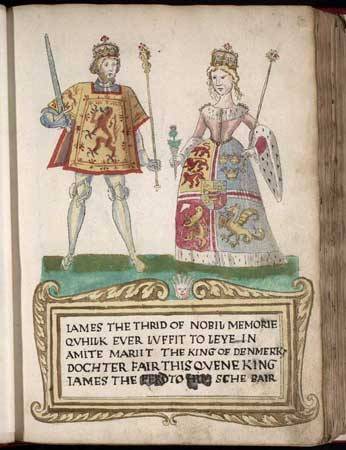
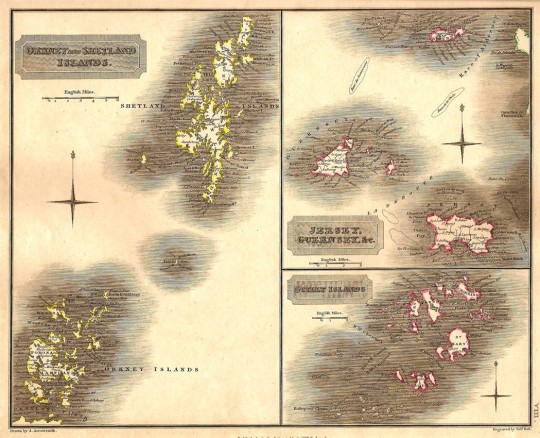
On 8th September 1468 King Christian I contracted the marriage of his only daughter Margaret Oldenburg, Princess of Denmark to James III.
The marriage ended up with The Northern Isles of Shetland and The Orkneys being ceded to Scotland.
After Norway was peaceably united with Denmark under King Christian I – his Oldenburg dynasty is still on the Danish throne – in 1450, he concentrated on building his empire in Scandinavia and seems to have had little time for his westernmost provinces of Orkney and Shetland. Christian also did not want any further warring with the Scots, and in 1468 a dynastic marriage was arranged between his 12-year-old daughter Margaret and James III – who had been on the throne since 1460 but who was still only 16 or 17. They married at The Palace of Holyrood House Abbey in 1469, a year after the signing of the Treaty of Copenhagen – sealing the friendship between Denmark/Norway and Scotland.
By that treaty, Margaret of Denmark’s dowry included the cancellation of debts allegedly owed by Scotland but most importantly King Christian offered 60,000 guilders or Rhenish Florins to James, with a mortgage secured on Orkney and Shetland. The first payment was due immediately after the marriage, but Christian was short of currency and the payment was not made. It seems he really did want shot of the islands ordered his subjects there to pay their taxes to the King of Scots until he could pay the redemption money. He never did pay up and effectively handed over the islands to Scotland.
James III also made it clear that he wanted the islands, and in 1470 he "persuaded" the Earl of Orkney, William Sinclair, to sign over his earldom to the king himself in return for some lands in Fife that included Ravenscraig Castle.
Now as Earl of Orkney – King Christian did not object – all that remained for James to do was to get the Scottish Parliament to formalise the annexation, and that finally happened in February 550 years ago.
The Shetland Museum and Archives website described what happened next:
“[James] promised that they shouldn’t be given away in time to come to anyone, except one of the king’s legitimate sons. His plan was that the islands should be governed by the Scottish crown, and administered on the king’s behalf by his own governors and tax-collectors – while leaving open the possibility that they might be gifted to a respectable nobleman sometime in the future. So in August the same year James appointed the bishop of Orkney, Andrew Pictoris, as his agent in Orkney and Shetland. King Christian didn’t complain.
“And something else happened, again in 1472, that was equally far-reaching. Six months after the annexation Pope Sixtus VI created an archbishopric in Scotland, based at St Andrews. He attached the bishopric of Orkney to it. At a stroke the ecclesiastical affairs of Orkney and Shetland had been taken over by the church in Scotland, just as their royal administration had been.”
Many nobles in Denmark and Norway were upset at King Christian for letting Orkney and Shetland go, and his successors King Hans and King Christian II were put under pressure to renounce the Treaty and take possession of the islands once again. They found excuses not to do so with Christian II being particularly hypocritical as he wrote to the islanders in 1514 that they were rightly under the crown of Norway despite being “pawned” to Scotland. It wasn’t until the 1660s that Denmark stopped claiming the islands.
For many decades Orkney and Shetland kept their own distinctly Norse polity, the islands have been part of Scotland since February 472, but the foundations for that were laid on this day in 1468.
The first pic is Christian, the couple are James III and Margaret.
7 notes
·
View notes
Text

Carpet with Palm Trees, Ibexes, and Birds
Probably made in present-day Pakistan, Lahore, late 16th–early 17th century
Cotton (warp and weft), wool (pile); asymmetrically knotted pile
This carpet, with its pictorial depiction of trees, birds, and animals, is conceived like a textile with a repeat design in which each unit reverses the direction of the preceding one. The ibexes, Chinese mythological beasts called qilins, and animals in combat, are derived from Safavid Persian art, as is the border design of cartouches and star-shaped medallions with cloud bands. The palm tree, however, is a very Indian feature, as is the generally naturalistic drawing of the flora and fauna and the bright red color of the field. The relationship to Persian carpet design dates this example to the early Mughal period, soon after the first carpet workshops were established by the emperor Akbar in Lahore, Agra, and Fatehpur Sikri.
Although the advent of carpet weaving in India predates his reign, it was the Mughal emperor Akbar (r. 1556–1605) who established imperial workshops for carpets, as well as a pattern of royal patronage. Carpet workshops were set up first at Fatehpur Sikri, the imperial capital only from 1571 to 1585, then at Lahore and Agra, and then, before 1640, at Kashmir.[1] Not all Indian carpets surviving from these early times necessarily suggest imperial manufacture, so commercial workshops must also have been in full production. Masters and workmen, many undoubtedly Iranian, are known to have come to India to help establish the workshops, and Persian carpets also clearly continued to be imported despite the high quality of local production.[2]
It should not be surprising, then, that this large carpet, representing production dating from late in the reign of Akbar, displays strong Persian influence. The most popular Persian convention was the symmetrical arrangement of scrolling vines with blossoms and leaves, but another approach was the use of pictorial patterns similar to those produced for paintings in royal manuscripts (the two conventions are combined in some examples). The field pattern here combines animals, birds, and vegetation in a pictorial way, that is, they are meant to be seen from one direction and without the matrix of a vine-scroll pattern to connect everything. Pictorial designs can be found in Persian carpets in a few examples of the small "Kashan" rugs and even more in a couple of pieces of the "Sanguszko" group; direct contact of some sort is also implied by the use of certain colors. Counterparts of several animals represented here may be seen in one of the Museum’s Persian rugs (no. 14.40.721), notably the leaping ibex, the combat between lion and ibex, and the leaping lion. Flames at the shoulders, indicating supernatural qualities, betray the ultimate Chinese origin of some of these figures, as transmitted to Iran in preceding centuries.
In many respects, however, this carpet is unmistakably Indian. In terms of structure, the cotton warps are eight-ply instead of the four-ply typically found in Persian carpets. As for color, the palette has a brightness, especially in the red, lacking in most Persian pieces, and there is a heavy use of ton-sur-ton coloring, juxtaposing similar colors such as red and pink, light and dark blue, and ocher and beige or off-white. The interlocking compartment design of the main border is related to borders found in Persian carpets (see MMA no. 1978.550), but here it takes a particularly Indian form in its geometricized compartments and the particular silhouette effect of the un-outlined red palmettes and vines set against the white ground. And the palm trees strike an Indian chord. As large as this carpet is, far larger ones are known to have come from Indian looms, including a pair of mid-seventeenth-century audience carpets, each about sixty-three feet long (approximately 19 meters).[3]
Daniel Walker in [Ekhtiar, Soucek, Canby, and Haidar 2011]
Footnotes:
1. Walker, Daniel. Flowers Underfoot: Indian Carpets of the Mughal Era. Exhibition catalogue, Metropolitan Museum, New York, 1997, pp. 7, 12.
2. Abu’l Fazl ‘Allami. The A’in-i Akbari by Abu’l Fazl ‘Allami. Translated by H[enry F.] Blochmann and H[enry] S. Jarrett; edited by D[ouglas] C[raven] Phillott. 3rd ed. 3 vols. 1927–49. Calcutta, 1977, vol. 1, p. 57.
3. Walker 1997 (see note 1), p. 120, fig. 118.
#carpet#palm#trees#ibex#birds#Pakistan#lahore#India#16th century#17th century#cotton#wool#Mughal#history#akbar#Daniel walker#long post#artifacts
9 notes
·
View notes
Text
Spacelab9 have revealed more details about the upcoming Dragon Age Vinyl box set. (It's a 70 track collection which will include songs from DA:O, DAII, DA:I, DLC and also some DA:I bard songs.)
I found this new info blurb about the cover art really interesting 👁️ (emphasis mine):
Deluxe package features all-original artwork by Dragon Age Concept Director Ramil Sunga and Lead UX Artist Danny Richardson, created exclusively for this album set. The beautifully detailed artwork presents a pictorial timeline following the lore of the Dragon Age series, beginning at the dawn of the Golden City, throughout the City's Fall and culminating in its re-emergence as the Black City, seat of the Old Gods. [source]
hello??? (the announcement blogpost for the vinyl contained the flavor text "From the land of Thedas, at the dawn of the Golden City".)
they also announced that the pre-sale for the box set was scheduled to begin April 27th (can't see it atm unless I'm missing it, maybe it's not yet started?) and that on the BioWare Gear Store it will begin on May 10th. each outlet will offer their own exclusive color variant of the vinyl.
lastly they also posted the full track listing (emphasis mine):
"DISC 1 SIDE A [DRAGON AGE ORIGINS]
1. DRAGON AGE: ORIGINS (2:49)
2. ELVES AT THE MERCY OF MAN (1:21)
3. RUINS OF OSTAGAR (1:18)
4. THE COMMON DWARF (1:24)
5. THE PARTY CAMP (0:44)
6. THE DALISH (1:18)
7. DARKSPAWN IN THE WILDS (1:13)
8. HUMAN NOBILITY (1:21)
9. URN OF SACRED ASHES (1:01)
10. JOIN THE GREY WARDENS (1:53)
11. BATTLE THE DARKSPAWN HORDES (1:05)
12. MAGES IN THEIR CHANTRY (2:01)
13. LELIANNA'S SONG (2:33)
DISC 1 SIDE B [DRAGON AGE ORIGINS]
1. THE CHANTRY'S HUBRIS (3:16)
2. THE NATURE OF THE BEAST (1:30)
3. TAVERN BRAWL (1:15)
4. THE DALISH ELVES ENCAMPMENT (1:18)
5. FERELDEN AT WAR (2:57)
6. KING EDRIN (1:32)
7. CHALLENGE AN ARCH DEMON (3:12)
8. THE CORONATION (1:03)
9. I AM THE ONE (HIGH FANTASY VERSION) (4:02)
DISC 2 SIDE A [DRAGON AGE II]
1. DRAGON AGE II MAIN THEME (2:03)
2. HAWKE FAMILY THEME (2:00)
3. QUNARI ON THE RISE (2:04)
4. LOVE SCENE (1:39)
5. VISCOUNT (1:29)
6. TAVERN MUSIC (2:11)
7. KIRKWALL ARRIVAL (5:13)
8. ROGUE HEART (3:12)
DISC 2 SIDE B [DRAGON AGE II]
1. JOURNEY TO DEEP FEAR (2:55)
2. MAGE PRIDE (4:03)
3. KIRKWALL TOWN ACT 2 EXPLORATION (2:05)
4. DARK DAWN (3:22)
5. FENRIS THEME (2:30)
6. NIGHT ATTACK AND VICTORY (1:56)
7. DESTINY OF LOVE (3:25)
DISC 3 SIDE A [DRAGON AGE: INQUISITION]
1. DRAGON AGE INQUISITION THEME (2:52)
2. THE WRATH OF HEAVEN (5:25)
3. ESCAPE FROM THE FADE (1:14)
4. CALLING THE INQUISITION (1:59)
5. IN HUSHED WHISPERS (4:49)
6. THE WESTERN APPROACH (2:07)
7. JOURNEY TO SKYHOLD (1:48)
DISC 3 SIDE B [DRAGON AGE: INQUISITION]
1. THE DAWN WILL COME (1:58)
2. ORLAIS THEME (2:44)
3. THE SCAR (0:56)
4. SIEGE OF ADAMANT (1:14)
5. WICKED EYES AND WICKED HEARTS (3:35)
6. THEDAS LOVE THEME (1:59)
7. CHAMPIONS OF THE JUST (3:55)
8. SACRIFICE (1:01)
9. RETURN TO SKYHOLD (2:13)
10. EPILOGUE (1:10)
DISC 4 SIDE A (BONUS DLC TRACKS)
1. I AM THE ONE (DARK FANTASY VERSION) [DRAGON AGE: ORIGINS] (4:10)
2. MAIN THEME [DAI DESCENT DLC] (2:58)
3. AFTERMATH [DAI DESCENT DLC] (1:29)
4. DARK SOLAS THEME [DAI TRESPASSER DLC] (3:01)
5. QUNARI ATMOSPHERE [DAI TRESPASSER DLC] (2:41)
6. LOST ELF THEME [DAI TRESPASSER DLC] (3:58)
7. D'READ KODA (1:08) [HIDDEN TRACK]
DISC 4 SIDE B (DRAGON AGE: INQUISITION - THE BARD SONGS)
1. ENCHANTERS (3:23)
2. GREY WARDEN (2:12)
3. I AM THE ONE (1:58)
4. ONCE WE WERE (2:10)
5. RISE (1:26)
6. SERA (1:45)
7. FALL OF THE MAGISTER (3:01)
8. SCOUT LACE HARDING (2:08)
9. THE SLIGHTEST ONES (2:28)"
[source]
👁️ Hidden track - "D'Read Koda"? ^^ Koda like a coda? (of interest here is that the recent Mass Effect vinyl collection contained some previously unreleased and some rearranged/remastered music.)
[source]
#dragon age#bioware#video games#solas#long post#longpost#fenris#the fenaissance#mass effect#dragon age: dreadwolf#dragon age 4#the dread wolf rises#da4
104 notes
·
View notes
Text

Salamander, of the elemental variety
In terms of elemental forms it is a mistake to approach from a position of evolutionary taxonomy. As in all transitions from perpendicular realities, such creatures are born from and induce the mythological symbols that define their anatomy.
The concept manifests the symbol, the symbol communicates the concept, an oroboros of cause and effect that is no less existentially annoying for creating animals made of the idea of fire, which is so certain of itself it doesn't know that it shouldn't be able to burn your house down.
In practical terms, a salamander should be addressed in the same manner as a grease fire, by entrapping it in a fireproof metal vessel and blocking the oxygen flow. Without a source of oxygen, the creature will poof back to its native reality. Any major brand of charcoal briquette is adequate bait. Oily rags, old newspapers, and pre-1975 furniture will do in a pinch.
-Melinoë's Guide to Incursive Pests & Misidentified Phenomenon, 2005 edition.
Prompt and process under the fold.
Prompt: colorful smoke swirling off of a black background, in the style of fluid glass sculptures, light teal and orange, tangled forms, light red and blue, rendered in cinema4d, sculpture-based photography, distorted and elongated forms:: fullbody, a colorful smoke swirl with colorful lights on a dark background, in the style of fluid, glass-like sculptures, light cyan and orange, serge marshennikov, colorful layered forms, conrad shawcross, focus stacking, bold lines, bright colors:: a real Charmander, dinosaur with burning tail, salamander, dino-iguana, glowing flames, rocky terrain, sumatraism, lava tail, burning tail, background sharp earth, raptor, elegant pose, hawaii, outback, iguana, morning glow, stock photo, regal pose --ar 4:3 --s 50 --v 6.0
This prompt was made two autogenerated prompts I made from this image I made by blending smoke and glass textures with Midjourney's weird image prompting system:

The image also had image prompts, in this case, three different charmanders, two being experiments for a Harryhausen Pokemon "what if" pictorial set and one being a "real animal version" attempt:



And those are from multiple versions of MJ.
Eventually, resulting in this gen:

Which I composited with multiple other variants, rebuilt the claw and some other details, and then did color correction and processing.
#midjourney v6#generative art#unreality#microfiction#salamander#elemental#fantasy#mythology#charmander#midjourney edit#ai assisted art
22 notes
·
View notes
Text
NAKAMURA YUKA.
⸺ MIZARU .
ability - user under the guidance of the port mafia in yokohama, japan. one of the remaining ability users left after the defeat of paul verlaine ⅋ aspiring executive. leader of mirage. 23. she/her.
⁽ ¹ ⁾ ability : three wise evils. mizaru, 見ざる - see no evil. kikazaru, 聞かざる - hear no evil. iwazaru, 言わざる - speak no evil. based on “three wise monkeys” the japanese pictorial maxim of which there are two connotations. ⁽ ¹ ⁾ in buddhist tradition, it represents avoiding evil thoughts and wrongdoings. ⁽ ² ⁾ to the west, it means turning a blind eye to evil and impropriety.


for starters, mirage is an assault group within the port mafia adhering to the order of the executives, alongside the likes of the black lizard. made up of five key members and a battalion, three of which are ability users, mizaru at their head. they work on tactical subjugation due to the nature of mizaru's ability being able to rid entire opposing squads of their sight and hearing. this makes them a prime choice for any necessary assassinations in tandem with other port mafia groups and members such as akutagawa gin. they have been known to be sent overseas.
⸺ MIZARU .
NAKAMURA ( 中村, middle village ),
YUKA ( 有佳, exist, good ) .
raised in the slums of suribachi city, mizaru was discovered at thirteen by port mafia officers as they partook in a job in the surrounding area. feeling threatened, mizaru robbed them of their senses in attempt to force them to leave. seeing this as a potential advantage for the port mafia's ability - user arsenal, she was recruited.
originally named nakamura yuka, she decided to change this once she had joined the leagues of the port mafia and essentially cut herself off from her previous life, beginning anew. she chose to name herself after a division of her ability, mizaru - see no evil, as within the connotations of her ability's real - life basis, she partakes in the west's interpretation - turning a blind eye to evil and impropriety and using her ability to her advantage within this. ( in an alternative universe, mizaru was sought out by the hunting dogs and uses her ability in the search for justice, though the act of changing her name does not change. )
having started her life in suribachi city, on her left - hand mizaru is missing her index and middle fingers, having lost them in a street - fight. she won, but not before her opponent played dirty. one of the ability - users within mirage possesses the ability to form weapons and other objects from most raw materials, and as a result fashioned mizaru a prosthetic that takes the shape of a two - fingered glove, when worn she is able to hold objects as normal, it bends and moves as though her fingers are there.
her ability, three wise evils, works in nature as mizaru being able to rid others of their sense of sight, hearing and their ability to speak ( this works by closing their throat, cutting off their breathing in the process ). it has a large radius of around 25km, meaning it is effective in long - range disabling of enemy groups and she can use this on multiple bodies, so far without a sure limitation. she possesses the ability to choose which of those she targets, and can differentiate between ally and foe. to begin the process, she must speak the sense she is robbing.
three wise evils exists as a give and take ability, meaning that whichever sense mizaru rids her victims of, she must give one up in return. if mizaru chooses to rob someone of their sight, she must give up her hearing or speech, if she robs them of their hearing she must give up her sight or speech. almost always the former, as ridding herself of her ability to speak closes her throat, too. she can use these in tandem and rid someone of two of their senses, but then she must give up whatever is left for herself.
due to the nature of her ability, mizaru is always accompanied by another member of mirage whose task, when mizaru is using her ability, is to be her eyes / ears. think - those cute little fish that stick to the sides of sharks and clean them, except this isn't cleaning it's just a protective contingency to make sure she isn't ambushed or set upon in order to stop the darkness and silence.
a skilled weapons user, she carries a standard issue handgun and an array of knives holstered to her belt. she is skilled in evasive and defensive techniques, but is also a proficient close - range fighter, being that she can control when her opponents can see or hear her.
personality wise, honest, assertive and balanced within her own ego. like many within the port mafia she is steadfastly loyal, they gave her a home when she had nothing, and she lost a great deal in wake of the defeat of paul verlaine as his singularity caused dire losses within the port mafia's gifted.
she is guilt - prone if things go wrong, places a great deal of responsibility on herself to care for those in her charge. in nature she is highly observant and can be cruel to those outside of her circle ie. the port mafia, mirage, and those who seek to threaten them. mizaru is advantageous and aspirational within her goals to ascend in port mafia hierarchy and constantly outdoes herself. she can be apathetic towards pain in others, yet she is earnest and sincere when the need for it arises. notorious grudge - holder, but good - natured and easy to get along with. due to the nature of her ability and her position within mirage, and thus the port mafia, she has an outwardly intimidating persona, but once that has gate has been opened she is easy to be around.
with enemies, she likes to play with them before handing them off. her ability is widely used for questioning others alongside tactical subjugation.
6 notes
·
View notes
Text

Christian Krohg - Albertine to See the Police Surgeon (1885-87)
The painting "Albertine to See the Police Surgeon" is realism at its most effective. It was regarded as scandalous when it was first exhibited, but now it is viewed as a success. The work incited widely divergent views, and the debate was heated. Why was this painting the subject of such intense controversy?
In March, 1887, there was a constant stream of people making a beeline to the street Rådhusgata in Kristiania every day. They were heading to see a painting on display. It was unusual for pictorial art to attract so much attention from the city’s inhabitants, but now both the bourgeoisie, who were typically interested in art, and members of the working class were eager to view "Albertine to See the Police Surgeon".
What they got to see was a full-scale depiction of an everyday situation among the city’s prostitutes. It was as though Krohg had torn down the wall of the police surgeon’s waiting room on Møllergata, and was inviting people in to see what many knew was going on, but avoided talking about. Krohg, however, was fearless, and wanted to trigger a social debate. Only a few months earlier his novel Albertine had been published. The novel is about a poor working girl who is summoned to the police surgeon after having been raped by a police superintendent. She subsequently ends up as a prostitute. The novel was confiscated by the Ministry of Justice immediately after publication. It was especially the rape scene and the description of the gynaecological examination by the police surgeon that were deemed inappropriate for a novel.
Prostitution had been illegal in Kristiania since 1842. All the same, the public authorities tacitly accepted it by providing compulsory medical check-ups and health controls. It was argued that the examinations of prostitutes were necessary to prevent the spread of venereal disease. Krohg saw this as a double standard, and he sought to put an end to this regulation and the systematic degrading and unlawful treatment to which impoverished women were subjected. In the painting, Albertine is placed in the background. She is clearly ashamed and embarrassed. She is dreading the examination, as the young women no doubt did in reality.
Krohg, along with many others, believed that the confiscation of his novel was a breach of Article 100 of the Norwegian Constitution, protecting freedom of expression. He brought the case before the Supreme Court, but lost and was forced to pay a fine. The painting was not confiscated, but the fact that the motif was closely associated with the prohibited book meant that several venues refused to exhibit the picture and some newspapers declined to print articles about the case. Eventually the debate came to revolve around freedom of expression in addition to the situation that the book and the picture criticised: that public prostitution had not yet been abolished, despite being prohibited by law. (source)
62 notes
·
View notes